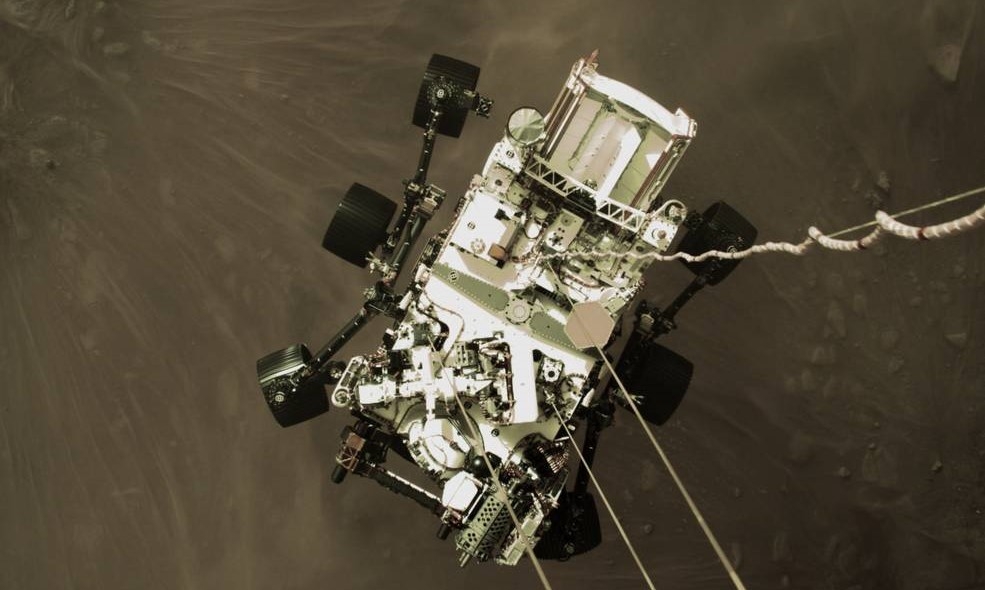
NASA Perseveres on Mars
The Mars Perseverance rover has finally landed on Mars, after years of planning and months of travel, laying the groundwork for years of scientific discoveries and future missions.
The rover, which will attempt to study Mars to find the chemicals that provide evidence that life once lived there, is a NASA project that launched last July and finally landed in Jezero Crater on the red planet on February 18th. Building on the success of the Curiosity rover, which landed in 2012 using some similar design elements, Perseverance will use its sampling tools to look for signs of ancient life. While Mars is desolate now, the planet once had a richer atmosphere and running water on the surface that did not quickly evaporate as it does now. Life might still linger there, or at least signs that life was there.
The plan is to “spend at least one Mars year (two Earth years) exploring the landing site region”. The lasting success of previous landers–Curiosity, for example, has already outlived its planned mission duration by several years—mean that Perseverance could be transmitting data from the surface for much longer than that. The low cost of maintaining a rover relative to the unique information they gather makes them difficult programs to cancel, even years after landing.
Four days after landing, the Perseverance team had finished the slow download process for video from our neighbouring planet, and for the first time ever, presented footage of the landing itself.
Dubbed the “seven minutes of terror”, the entire landing program was started and finished before us Earthlings received any data about it. The rocket carrying Perseverance arrived at Mars travelling at over 19,000 kilometres per hour, and since light takes about 11 minutes to travel from there to here, the whole process was done automatically. Thousands watched NASA and others stream the event live to see a new mission to understand the Martian landscape begin.
Like Curiosity before it, Perseverance dealt with the difficulty of landing such a heavy rover at such a fast approach through use of its Sky Crane. After the heat shield and the backshell protecting the machinery falls away, the rover is literally lowered to the surface of Mars while suspended in the air by cables in a more gentle, powered descent. Just as planned, when the rover sensed that it was safely on the ground, the cables detached, freeing the crane to “make its own uncontrolled landing on the surface, a safe distance away”. (That’s NASA-speak for “crash”.)
The rover carries all sorts of new experimental technology for understanding the next planet humans will visit. Expect tools like Perseverance’s advanced cameras, Mastcam-Z and SuperCam, to study the mineral composition of rocks and regolith (Martian soil) from a distance, while also generating more high-quality background images for space enthusiasts. In preparation for future human missions, the Mars Oxygen In-Situ Resource Utilization Experiment (MOXIE) will produce oxygen from Martian atmospheric carbon dioxide, for use as rocket fuel on the return trip or, say, to help future astronauts breathe.
If all goes well, an onboard experimental helicopter named Ingenuity will attempt the first controlled flight on another planet. The project is mainly a proof-of-concept to see if future missions could use similar technology, although giving future Mars missions the ability to view the land from different angles over impassable terrain will provide all sorts of unknown benefits.
In particular, the rover will not only study the Martian environment itself with onboard tools, it will store samples it collects, allowing a future Mars mission, already in the works, to collect those samples and return them to Earth. Plans for this project are already underway, with support from the European Space Agency (ESA), and the samples are expected to be collected and returned sometime in the 2030s. This would be a historic project, allowing humans to study Mars up close using samples directly in a lab, much like the samples collected from the Moon aided scientific understanding during Apollo.
The safe landing of Perseverance is a big success for NASA, and their traditional approach to scientific exploration. At a time when NASA’s new human exploration rocket, the Space Launch System (SLS), is years overdue and billions over budget, the space agency has now completed another difficult rocket delivery to Mars, and continuing a string of successes since the last NASA Mars lander failed in 1999.
Sure, SpaceX has big plans to put humans on Mars as early as 2026, and China’s Tianwen-1 rover will be attempting a landing on Mars this spring. But for now the American space agency that pioneered Mars landings, and the aerospace juggernauts they contract with, are doing what they do best.
Photo: NASA/JPL-Caltech









